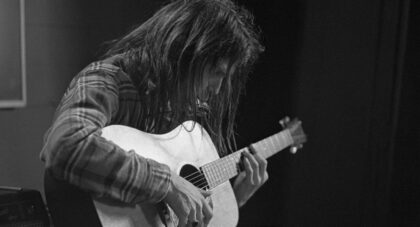The album opens with Charles Mingus sputtering a percussive motif with one hand while the other riffs out an arabesque fantasia. There’s a duality present here, a tension of opposites. A fixed pitch struggles with an ecstatic melody and the battleground is rhythm. This gives way to rich, rolling chords, which develop into a strange waltz that hums along in Mingus’ “leaky faucet” time. The piece unfolds like a dreamlike tremor, a sort of musical fingerprint of the artist’s unconscious, and is aptly titled “Myself When I Am Real.” In the liner notes, Mingus tells Nat Hentoff, perhaps the only jazz critic he could ever stand, “I go into a kind of trance when I’m playing this kind of number. I remember that when we were recording this one, I noticed suddenly I didn’t seem to be breathing.”
Aside from its breath-taking beauty, Mingus Plays Piano is a remarkable document in that it is Charles Mingus’ only solo record and he doesn’t even play the bass. He tables his virtuoso upright skills entirely for the instrument on which he composed. The album is an intimate portrait that reveals Mingus’ process and practice–not only his command of musical ideas but also his deep fluency and broad imagination. The material is rich and style expansive, however there’s playfulness to this LP, an understated, casual mood, like he’s jamming in your kitchen. Recorded in a single session on July 30, 1963, it’s an odd and often overlooked piece in the Mingus catalogue that contrasts and compliments his intricately orchestrated and technically challenging works of that time. Long out of print, SF archival label Superior Viaduct remastered and reissued this subtle masterpiece earlier this year.
Mingus Plays Piano originally was released on the heels of The Black Saint And The Sinner Lady, a brilliantly orchestrated, album length composition performed by an eleven piece band of frequent Mingus collaborators. The Black Saint was a career highlight, but the year leading up to that success was a tumultuous one. In 1962, Mingus toured heavily, and for his band’s residencies in NYC, he experimented with hiring a bassist and playing piano himself. He agreed to record a live album with a big band iteration of his Jazz Workshop for United Artists. Rushed preparations for this maximalist composition resulted in an incident where he punched his longtime trombonist Jimmy Knepper in the mouth. The 31-piece band’s one night stand at Town Hall was sloppy, and Mingus raged as concertgoers walked out and demanded a refund. After that disastrous performance, Mingus was exhausted, had gained a lot of weight, and suffered from painful ulcers. His wife Judy had just delivered a stillborn baby girl. The couple retreated to the Bay Area where Farwell Taylor, Mingus’ old beatnik-guru friend, straightened him out with a weeklong juice cleanse.
Only the good shit. Aquarium Drunkard is powered by its patrons. Keep the servers humming and help us continue doing it by pledging your support.
To continue reading, become a member or log in.


